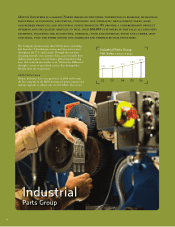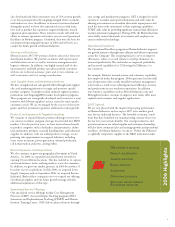Napa Auto Parts 2006 Annual Report Download - page 20
Download and view the complete annual report
Please find page 20 of the 2006 Napa Auto Parts annual report below. You can navigate through the pages in the report by either clicking on the pages listed below, or by using the keyword search tool below to find specific information within the annual report.Management’s Discussion and Analysis of Financial Condition and Results of Operations (continued)
2006
Operating Expenses
Selling, administrative and other expenses (“SG&A”) increased to
$2.4 billion in 2006, representing 22.8% of sales and down slightly
from 22.9% of sales in 2005. SG&A expenses as a percentage of
net sales reect the benets of our cost control initiatives. Our
cost management initiatives continue to emphasize continuous
improvement programs designed to optimize our utilization of
people and systems. We were pleased with the success of our
initiatives and expect our SG&A expenses as a percentage of
sales to show progress in the foreseeable future. Depreciation
and amortization expense in 2006 was $73 million, up 12% from
2005, which relates to the increase in capital expenditures in the
current year. The provision for doubtful accounts was $16 million
in 2006, consistent with our bad debt expense in 2005.
In 2005, SG&A increased to $2.2 billion, or 22.9% of net sales,
a slight increase from 22.8% of sales in 2004. Depreciation
and amortization expense in 2005 was $66 million, up 5% from
2004, and corresponds to the increase in capital expenditures
in 2005 relative to the prior year. The provision for doubtful
accounts was $16 million in 2005, down from $21 million in the
prior year. This was due to our improved collections on accounts
receivable balances relative to 2004, when the Company incurred
unusually high bad debt losses.
Non-Operating Expenses
Non-operating expenses for the Company consist primarily
of interest. Interest expense was $32 million, $34 million and
$39 million in 2006, 2005 and 2004, respectively. The decrease
in interest expense in 2006 is primarily due to the termination
of an interest rate swap agreement.
In 2005, the decrease in interest expense from the prior year relates
to the repayment of borrowings during 2004 to its current level.
In “Other”, interest income net of minority interests increased in
both 2006 and 2005 due to the change in interest income earned
on the Company’s cash balances.
Operating Prot
Operating prot was $846 million in 2006, an increase of 7.4%
from $788 million in 2005. Operating prot as a percentage of net
sales, which we refer to as operating margin, was 8.1% in 2006,
reecting no change from our operating margin achieved in 2005
and 2004. Our constant operating margin over the last three years
is primarily the result of specic short-term margin issues in
Automotive, which offset the benets of our overall improvement
in gross margin and SG&A expense as a percentage of net sales
over these periods. We discuss these issues further below. We
remain optimistic that our margins will show improvement in
the year ahead.
Automotive Group
Automotive operating margins decreased to 7.7% in 2006 from
7.9% in 2005. During 2006, the Company recorded non-recurring
costs associated with certain closing and consolidation expenses
at Johnson Industries and our re-manufacturing operations. At
Johnson Industries, we sold or closed eight of twelve locations
during 2005, resulting in selling and closure costs in that year,
and we incurred additional costs to downsize these operations
in 2006. At our re-manufacturing operations, we incurred costs
during the year related to certain facility consolidations.
Automotive operating margins decreased to 7.9% in 2005 from 8.4%
in 2004. Despite showing progress in our core NAPA operations,
Automotive was challenged with specic issues at Johnson
Industries, as discussed above, and, within the re-manufacturing
operations, we made some price adjustments to certain product
lines to drive sales growth, resulting in lower margins for this
group relative to the prior year. We consider the issues reviewed
for 2005 and 2006 to be short-term challenges for this group
and believe our Automotive operating margins will show improve-
ment in the year ahead.
Industrial Group
Industrial operating margins increased to 8.3% in 2006 from
7.7% in 2005. This represents the third consecutive year of margin
improvement for Industrial and reects the effectiveness of our
sales and operating initiatives, as well as the relative strength of
the industries served by Industrial over these periods. Industrial
operating margins increased to 7.7% in 2005 from 6.9% in 2004.
This was the largest margin gain among our business segments in
2005 and reects the strong performance at Industrial for the year.
Ofce Group
Operating margins in Ofce were 9.4% in 2006, down slightly
from 9.5% in 2005. Ofce continues to generate industry leading
operating margins despite competitive pricing pressures in the
industry. These pressures are offset by ongoing product and
customer expansion efforts and the continued development of
effective marketing programs and dealer services. Ofce operating
margins were 9.5% in 2005, down from 9.8% in 2004. The success
of this Group’s sales initiatives was offset by pricing pressures,
which resulted in the decrease in operating margin in 2005.
Electrical Group
Operating margins in Electrical increased to 5.5% in 2006 from
5.1% in 2005. This represents the third consecutive year of margin
improvement for Electrical and reects the continued strength in
the manufacturing sector of the economy, combined with Electrical’s
successful growth strategy during this three year period. Operating
margins in Electrical increased to 5.1% in 2005 from 4.4% in 2004.
We are encouraged by the ongoing progress we see in Electrical.
18
























